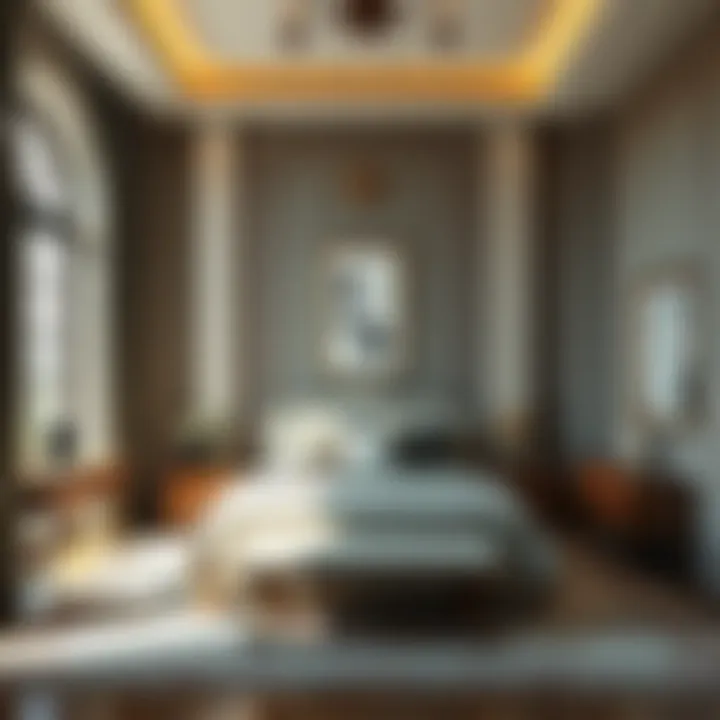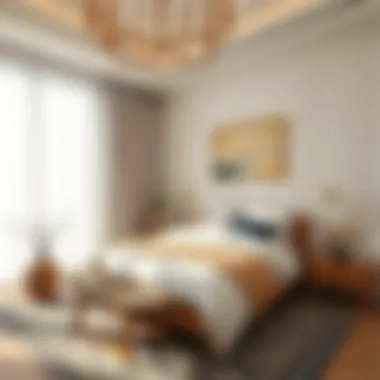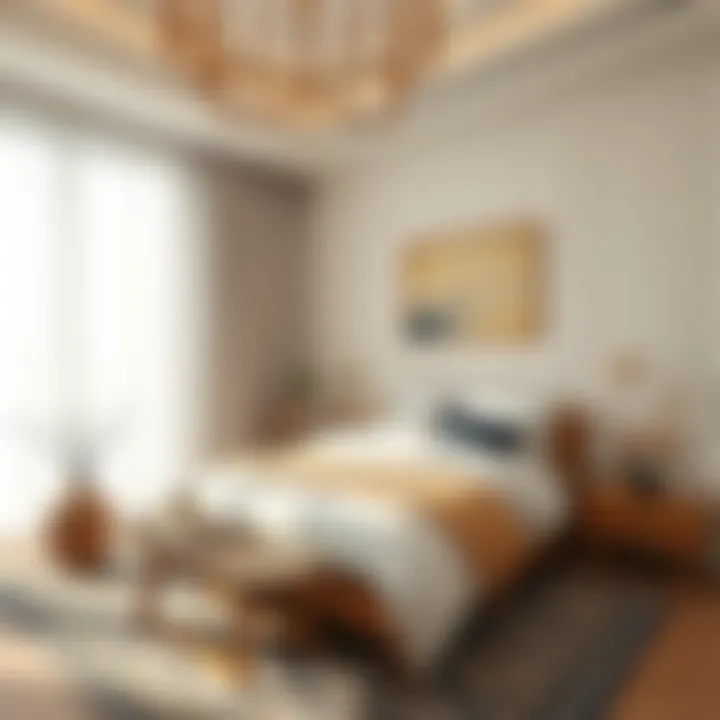Designing a Bedroom: Create Your Ideal Sanctuary


Intro
Creating a bedroom that feels like a sanctuary is a journey in itself. The bedroom is more than just a place for sleep. It acts as a personal retreat, where one can unwind, recharge, and express individual style. The goal of this article is to provide a comprehensive overview, guiding homeowners and design enthusiasts through the enchanting processes of spatial planning, color selection, and furniture arrangement.
When it comes to designing your ideal bedroom, there are numerous paths to explore. You may favor the sleek lines of modern design or prefer the warmth of rustic elements. Regardless of your taste, understanding the key aspects of bedroom design can help you cultivate a space that appeals to both your aesthetic values and practical needs.
Throughout this guide, we will touch upon the latest trending styles, delve into thoughtful color palettes, examine how material selection can impact the overall feel, and consider the best ways to arrange furniture to enhance functionality and flow. By understanding these elements, you can tailor your bedroom to fit your lifestyle and aspirations, turning an ordinary space into a serene sanctuary.
Trending Styles
Modern Minimalism
Modern minimalism speaks to an inherent desire for simplicity and clarity. It’s characterized by its sleek lines, open spaces, and a color palette that often leans toward monochromatic shades or soft pastels. When incorporating modern minimalism into your bedroom, consider the following:
- Lack of Clutter: Emphasize open spaces with minimal décor, focusing on essential furniture pieces that serve multiple functions.
- Natural Light: Let the light shine through. Opt for large windows and lighter materials to brighten the space.
- Linear Design: Use furniture that emphasizes straight lines, such as low-profile beds and geometric nightstands.
This style not only looks good but also creates a sense of tranquility that many strive for in their bedrooms.
Cozy Rustic
On the other hand, cozy rustic design offers a warm and inviting atmosphere. Imagine wooden beams, textured fabrics, and accent pieces that reflect nature. Here are several ideas to capture that rustic feel:
- Materials: Incorporate natural woods and organic textiles, such as linen or wool, to add warmth.
- Earthy Color Tones: Use hues like deep greens, browns, and warm creams to forge a connection with nature.
- Personal Touches: Add handmade items or vintage finds to make the space uniquely yours.
This style brings a sense of comfort, perfect for unwinding after a long day.
Color Palettes
Calming Neutrals
Neutral colors can act as a backdrop, creating a canvas where other design elements shine. Gentle grays, beiges, and whites foster a calming atmosphere. These colors make the space feel more expansive and promote relaxation. Here’s how to utilize calming neutrals effectively:
- Accent Walls: Create a subtle focus by painting one wall in a slightly darker neutral shade, adding depth to the room.
- Layer Textures: Mix materials in the same color family to create visual interest without overwhelming the senses.
Bold Accents
For those who crave a splash of color, bold accent tones can be incorporated to heighten the design impact. You might consider:
- Statement Furniture: A bright armchair or colorful bedding can serve as focal points in an otherwise neutral space.
- Artwork and Accessories: Incorporate vibrant art or decorative pillows that draw the eye and communicate personality.
Utilizing bold accents strategically can invigorate the room while maintaining balance.
Understanding Your Space
Creating a bedroom isn't just about picking out nice bedspread and painting walls a trendy color. It’s a symphony of thoughtful design choices and practical considerations that together form your personal sanctuary. Understanding your space is foundational because it paves the way for your entire design journey. This stage ensures that whatever choices you make later on feel harmonious rather than haphazard.
Assessing Room Dimensions and Layout
Before diving headfirst into paint chips or furniture shopping, take a step back and measure your room. Knowing the dimensions gives you a blueprint to work with and helps avoid common pitfalls—like trying to shove a king-sized bed into a space barely big enough for a twin.
Start by using a tape measure to note down the length and width of your bedroom. Consider the doorways and windows; their position can guide the arrangement you eventually choose. Also, think about the circulation space within the room. You don’t want to feel like you’re tiptoeing around furniture like a game of Twister every time you need something.
Key factors:
- Proportions: Make sure the furniture fits; a bulky dresser might overshadow a cozy chair.
- Zoning: Blend sleeping, dressing, and reading areas without making it feel cramped.
Identifying Natural Light Sources
Natural light plays a monumental role in how livable a space feels. Pay attention to how sunlight flows into your room during different times of the day. Is there a particular corner that turns into a sun-drenched haven around midday? Or maybe an area that always feels dark despite a strategic lamp placement?
Utilizing these light sources is about more than aesthetics; it can affect your mood and energy levels. Consider the following:
- Window Treatments: Use lightweight curtains to keep the light flowing while maintaining privacy.
- Mirrors: Placing mirrors opposite sources of light can amplify that natural glow, making your room feel more spacious and inviting.
Considering Privacy Needs
Your bedroom should feel like a private retreat, shielded from the hustle and bustle of the outside world. This might mean considering how close your home is to neighbors or how much visibility there is from the street. Think about your comfort levels and what type of barriers you need.
- Window Placement: If you're on the ground floor or in close proximity to other homes, think about frosted windows or strategically placed tall plants.
- Landscaping: Exterior elements like trees or shrubs can add natural privacy.
- Sound Barriers: If noise is a concern, soft furnishings may help absorb sound. Think thick carpets and heavy curtains.
A bedroom that honors these considerations isn’t just about looking good; it promotes overall well-being, allowing you to unwind and rejuvenate in your personal space.
Choosing the right design elements based on a thorough understanding of your space sets the tone for every aspect of your bedroom design journey, emphasizing both utility and comfort.
Defining Your Aesthetic
Defining the aesthetic of your bedroom is more than just picking pretty colors and cute decorations. It serves as the foundation of how your space feels and functions, blending personal taste with practical considerations. A thoughtfully defined aesthetic creates a cohesive look that reflects your personality and lifestyle, making the space more comfortable and inviting. This concept is crucial because it guides every other decision in the design process, from furniture selection to color choices and layout.
Exploring Design Styles
Understanding various design styles can significantly enhance the overall character of your bedroom. Each approach has its own unique charm and practicalities, which cater to different preferences and needs.
Modern
The modern design style stands strong on sleek lines, minimal ornamentation, and a focus on functionality. Its clean aesthetic can contribute to a serene and uncluttered space, perfect for relaxation. One key characteristic is the use of neutral colors accompanied by a few accent pieces, giving a polished yet approachable feel. This style’s primary feature is its emphasis on open spaces and muted tones that promote tranquillity.
While modern design offers cleanliness and sophistication, it may feel too bare for those who prefer a more personalized touch. However, through strategic accessorizing, you can still infuse warmth and character into a modern bedroom.
Minimalist


Minimalism takes simplicity to heart by focusing solely on essentials. It promotes a decluttered environment, fostering clarity of thought and calmness, which is increasingly relevant in today's fast-paced world. A significant trait of minimalist design is the mantra "less is more." This approach can be a great choice for homeowners keen on mental clarity. It generally favors monochromatic color schemes complemented by natural materials.
The unique feature of minimalism is its ability to create a visually peaceful setting that emphasizes open space. Though some might find it lacks warmth or comfort, incorporating textiles or personal mementos can easily counterbalance that feeling.
Rustic
Rustic design embraces nature and simplicity, often utilizing reclaimed wood, stone, and earthy textures. It creates a cozy, inviting atmosphere that radiates warmth and comfort. One prominent characteristic of this style is its emphasis on natural elements, which fosters a connection between the indoors and the outdoors. The rustic aesthetic can transform your bedroom into a peaceful retreat that feels grounded and serene.
However, while it provides comfort, rustic designs may not suit everyone. The tendency towards darker colors and heavy textures can occasionally overwhelm a space. Still, the benefits of warmth and authenticity from rustic elements make it a worthwhile consideration for many homeowners.
Bohemian
Bohemian style is all about eclectic, free-spirited design that mixes colors, patterns, and cultures. It encourages personal expression and individuality, making it excellent for those who love unique and diverse influences. A key signature of Bohemian design is its layered textures and vibrant colors, creating an inviting ambiance rich in detail and depth.
The unique aspect of a Bohemian space lies in its diverse array of textiles and art, fostering creativity. However, the combination of various elements can easily veer into chaos if not managed carefully. So, it’s essential to maintain a balance, ensuring that the space remains inviting without feeling disorganized.
Creating a Mood Board
Now that you've identified potential styles, it's time to merge these ideas into a tangible vision. Creating a mood board can help visualize your aesthetic and guide your choices. Gather samples of fabric, paint swatches, and images that inspire you, placing them together to form a cohesive theme for your bedroom. Different layouts and combinations will reveal what resonates most with you. This exercise not only clarifies your vision but also serves as a reference point throughout your design process, keeping your decisions aligned with your aesthetic goals.
Choosing the Right Color Palette
Selecting the right color palette is like adding the finishing brush strokes to a carefully crafted canvas. It holds the power to transform an ordinary bedroom into a soothing retreat or a vibrant sanctuary. In the realm of bedroom design, the color palette sets the tone, influences mood, and even alters perceptions of space itself. It’s not just about what suits the eye, but rather, it’s about creating a harmonious environment that resonates with personal preference and lifestyle.
Understanding Color Psychology
Colors are more than just visual stimuli; they evoke emotions and influence feelings. Understanding color psychology can help homeowners make informed decisions about their space.
- Cool Colors: Shades like blues and greens are known to promote calmness and relaxation. Imagine coming home to a tranquil sea-green haven after a long day; it’s like a breath of fresh air.
- Warm Colors: Reds, oranges, and yellows create an energetic atmosphere. These hues can invigorate a space and make it feel lively and inviting. However, moderation is key; too much heat can create a sense of anxiety.
"Choose colors that sing to your soul; your sanctuary should reflect what makes you feel most at home."
Combining Shades Effectively
Once a primary color is selected, combining shades can create depth and interest. A well-thought-out combination can elevate a room from drab to fab.
- Monochromatic Schemes: Stick to one base color but vary its shades and tints. For instance, combining a light lavender with deep purple creates a cohesive, soothing effect.
- Complementary Colors: These are colors opposite each other on the color wheel, such as blue and orange. They create a dynamic contrast, adding excitement to your space.
- Analogous Colors: This involves three colors that sit next to each other on the wheel. For example, blue, blue-green, and green can produce a serene palette that feels connected and cohesive.
Avoid going overboard; aim for a balance that doesn’t overwhelm the senses. Too many clashing hues can create confusion, taking away from the desired sanctuary vibe.
Testing Paint Samples
Before settling on a permanent choice, testing paint samples is essential in the color-selection process. Samples are available at any local paint store and often come in small containers for easy application.
- Swatch Test: Apply larger patches to your wall rather than the typical tiny strips. This provides a clearer view of how the color interacts with the room’s lighting at different times of the day.
- Observe in Different Light: Colors can change dramatically from morning to evening. Make note of how each hue behaves under artificial and natural light to find what fits best with your existing environment.
- Get Feedback: Sometimes, what you see might differ from what others perceive. Asking family or friends for their impressions can help finalize choices.
In choosing the right palette, it’s essential to remember that color is a personal expression. It affects the emotional quality of the room and therefore is worth the time and consideration it demands.
Selecting Furniture
Selecting furniture is one of the most critical elements of designing a bedroom. The right furniture can create a balanced and comfortable environment, transforming a plain space into a private oasis. Not only does it define the layout and functionality of your room, but it also influences your overall sense of style and well-being. When choosing furniture, understanding your personal needs and preferences is essential. Here are some key aspects to consider:
- Functional Needs: Think about how you use the space. Do you need extra storage for clothing? Is a large bed essential?
- Aesthetic Appeal: Your furniture should reflect your individual taste and the atmosphere you wish to create in your sanctuary.
- Quality and Durability: Invest in furniture that’s not just attractive but also lasts. Quality materials make all the difference in both comfort and longevity.
Determining Essential Furniture Pieces
Bed Frame
The bed frame is arguably the centerpiece of any bedroom. Its most important role is to provide both support and style. A well-selected bed frame not only supports your mattress but also influences the aesthetic of the entire room.
- Key Characteristic: Look for a frame that combines sturdiness with design. Whether opting for a sleek modern look or a more ornate traditional style, the frame should fit harmoniously within your space.
- Unique Features: Some bed frames come equipped with built-in storage options, allowing you to maximize space without sacrificing style.
- Advantages and Disadvantages: While a higher price tag can mean better durability, one should not overlook budget-friendly options that still provide adequate support.
Dresser
A dresser plays an essential role in both storage and design. It’s not merely a utility item; it can enhance the visual appeal of your room while keeping it organized.
- Key Characteristic: Consider a dresser with smooth functionality, like soft-closing drawers, that provides ease of use.
- Unique Features: Some dressers offer mirror attachments or can double as a changing table, which could be useful in multi-functional spaces.
- Advantages and Disadvantages: While larger dressers offer ample storage, they can overwhelm small rooms. Striking the balance between size and functionality is crucial.
Night Tables
Night tables or bedside tables are more than just small surfaces to hold lamps and books. They provide a finishing touch to your bedroom ensemble.
- Key Characteristic: Look for tables that offer both surface space and storage, like drawers or shelves to store nighttime essentials alongside decorative pieces.
- Unique Features: Some modern designs incorporate charging ports or integrated lighting, making them more functional.
- Advantages and Disadvantages: While night tables may seem trivial, choosing the wrong height or style can throw off the room’s balance. A table that’s too low or high can become a nuisance at night.
Prioritizing Comfort and Functionality
Choosing pieces that prioritize comfort and functionality is key to creating a peaceful retreat. Your bed, for example, should promote good sleep health. Factors like mattress firmness, bed height, and even bedding materials can impact your comfort. Similarly, a chair or seating area in the room should invite relaxation without taking up too much space. Consider also the flow of the room; ensure each piece of furniture allows for easy movement and accessibility.
Incorporating Multi-functional Items
In today’s world, the more multi-functional your furniture is, the better. Consider a bed with built-in drawers or a ottoman that doubles as a storage unit. This approach not only maximizes your space but also minimizes clutter. Such items allow you to tap into the full potential of your bedroom while keeping it stylish and inviting. By focusing on versatile furnishings, you can create a space that meets a variety of needs, all without sacrificing design.
Optimizing Layout
The layout of your bedroom isn’t just a matter of placing furniture where it fits; it’s about creating a sanctuary tailored to your lifestyle. When designed thoughtfully, every piece of furniture and every corner can contribute to an inviting atmosphere. Understanding the concept of optimizing layout is vital in transforming a typical bedroom into a personal retreat. By focusing on specific elements like flow, circulation, and the strategic placement of furniture, you can enhance both the aesthetic and practical aspects of the space.
Establishing a Focal Point in the Room
Every well-designed space has a focal point that draws the eye and creates a sense of order. In the bedroom, this could be the bed itself—a grand headboard, beautifully made with soft linens, certainly commands attention. Alternatively, artwork, a striking light fixture, or an elegant piece of furniture can serve as a focal point. When establishing this element, consider the following:
- Pick a feature you adore: Whether it’s a chic piece of art or a vintage dresser, choose something that resonates with you.
- Use symmetry for balance: Arrange nightstands and lamps on either side of the bed to create visual harmony.
- Don’t shy away from height: Tall elements like potted plants or shelving can lead the eye up, creating a more spacious feel.


The focal point not only sets the tone but also guides your decisions regarding color, textile choice, and other decorative elements. A well-placed focal point can reduce clutter, focusing attention where it matters most.
Arranging Furniture for Flow
Next up is furniture arrangement, a critical aspect of optimizing your layout that often gets overlooked. A harmonious flow through the bedroom can make or break its functionality and comfort.
To ensure a smooth flow, keep these points in mind:
- Measure your space: Take accurate measurements of both the room and furniture to avoid awkward arrangements that hinder movement.
- Prioritize pathways: Ensure there are clear walking paths between major components—like the bed and the closet—so that daily routines flow quicker and more naturally.
- Consider multiple uses: If your bedroom serves more than just a sleeping space—think office nook or reading corner—designate areas that allow for these activities while keeping the layout open.
- Test various configurations: Before finalizing the layout, try different setups. Sometimes moving a piece a few inches can drastically change the dynamic and feel of the space.
Furniture arrangement is all about creating an inviting space where you can fully relax. The right flow can transform your nighttime rituals, making waking up and going to bed both seamless and pleasant.
"A room should never allow the eye to settle in one place. It should smile at you and create a sense of welcome." – Juan Montoya
Culmination
Optimizing your bedroom layout is not merely an art; it requires thoughtful planning and an understanding of how space is interacted with daily. By establishing a clear focal point and arranging furniture for optimal flow, you can create a bedroom that feels more like a sanctuary and less like a stopover. As you continue to design your ideal space, keep these elements in mind to ensure a bedroom that truly meets yours needs and preferences.
For further reading on design principles, you can check out articles from Wikipedia and Britannica.
Explore interior design forums on Reddit for more practical advice and inspiration.
Enhancing Ambiance with Lighting
When it comes to bedroom design, lighting plays a pivotal role in setting the overall mood. It influences not only how the room looks but also how it feels. Thoughtfully chosen lighting options can enhance comfort, promote relaxation, and even improve functionality. Different types of lighting serve various purposes—each contributing to a versatile environment that adapts to your needs, whether it's winding down after a long day or reading a book in bed.
Types of Bedroom Lighting
Ambient Lighting
Ambient lighting serves as the primary source of light in a space, providing an overall illumination that enhances visibility throughout the room. Common features of ambient lighting include ceiling fixtures, chandeliers, or recessed lights. This form of lighting is widely appreciated because it acts as a base layer of brightness.
One unique aspect of ambient lighting is its ability to create an inviting atmosphere. For instance, soft, warm-toned bulbs can transform a stark space into a cozy haven. However, too much brightness or harsh lighting can lead to discomfort, so it's crucial to select fixtures that emit a gentle glow rather than overwhelming brightness. Balancing this element carefully helps ensure that your design speaks comfort and serenity.
Task Lighting
Task lighting focuses on specific areas, facilitating activities such as reading, studying, or performing intricate tasks. Desk lamps, bedside lamps, and vanity lighting are classic examples. Key characteristics of task lighting include adjustable brightness and direction, which allow for customization based on the activity at hand.
This type of lighting is particularly beneficial in a bedroom since it provides the necessary illumination without disturbing others. The unique feature of task lighting lies in its practicality; you can direct the light exactly where you need it. On the downside, relying solely on task lighting can sometimes lead to shadows or uneven lighting, so it’s generally best combined with ambient sources for balance.
Accent Lighting
Accent lighting is all about highlights and drawing attention to specific elements in the room—the artwork on your wall, a decorative shelf, or architectural features. This type of lighting usually involves spotlights, wall-mounted fixtures, or picture lights. A key characteristic is its ability to create dramatic effects that can completely change the perception of a space.
The unique aspect of accent lighting is its capacity to infuse personality into the room. It can spotlight items that reflect your taste and style. However, overuse can lead to a cluttered visual experience, so it’s often wise to use accent lighting sparingly to maintain its impact.
Utilizing Dimmer Switches
Dimmer switches are a fantastic addition to any bedroom, allowing for adjustable lighting levels that cater to various moods and activities. Whether you’re winding down for the night or hosting a small gathering, dimmers provide the flexibility to manage the ambiance of your sanctuary effectively. With a simple twist or slide, you can transform bright, clinical lighting into a warm glow that invites relaxation. This ability to customize light settings makes dimmer switches not just a luxury but a practical design choice that enhances usability and comfort.
Incorporating Textiles
Textiles play an immensely important role in creating an inviting and comfortable bedroom. When chosen carefully, they can enhance the sensory experience of the space, offering warmth, texture, and personality. From bedding to curtains, the right fabrics can not only elevate the aesthetic appeal but also contribute to a sense of tranquility and relaxation.
Choosing Bedding and Linens
The selection of bedding and linens is crucial, serving as the foundation for comfort in the bedroom. High-quality materials, such as cotton or linen, provide breathability and softness. Opting for a thread count between 300 and 500 can strike a balance between durability and plushness. Remember to consider the seasonality; heavier fabrics may be great for winter, while lighter options will keep you cool in the warmer months.
Don't shy away from mixing patterns and colors. Using a neutral palette as a base and layering pops of color with throw pillows and blankets can easily transform the look of your bedding without overwhelming the senses. Investing in a comfy duvet or a cozy quilt can make the difference between a bedroom and a sanctuary.
"When it comes to bedding, remember, comfort trumps style. If you can't sleep well, all the fancy decor won't matter."
Selecting Curtains and Drapery
Curtains and drapery are not only functional, providing privacy and blocking out light, but they also serve as a pivotal element in setting the mood. Light, airy fabrics such as sheer cotton create an open and bright feel, while heavier materials like velvet can add a sense of coziness and drama.
Consider the color and pattern of the curtains. Lighter hues can make a room feel larger, while darker shades can make it more intimate. Make sure to choose lengths that complement your window sizes; floor-length drapes can create an illusion of height, whereas shorter curtains can make a room feel stubbier.
Adding Area Rugs
Area rugs anchor the space, providing a comforting underfoot experience that can drastically alter the feel of the bedroom. The right rug can bring together various design elements while offering warmth and insulating sound.
When selecting a rug, think about size, material, and texture. A rug that extends beyond the perimeter of the bed creates a cohesive look, whereas a smaller rug can highlight a seating area. Materials such as wool or synthetic fibers can offer durability while adding softness. Don’t forget about patterns! A bold geometric design can energize the room, while a subtle, muted hue can maintain a peaceful vibe.
In summary, textiles are more than surface elements in bedroom design; they infuse character and coziness into your sanctuary. Choosing the right bedding, curtains, and rugs can significantly affect aesthetics while also fostering comfort, rhythm, and emotional well-being. Whether you're selecting the fluffiest pillows or the softest sheets, textiles offer an incredible opportunity to personalize your space, making it uniquely yours.
Personalizing the Space
Personalizing your bedroom is no small feat; it's about crafting that unique atmosphere where you feel most at ease. Consider it the cherry on top of your design journey. A personalized space doesn’t just speak to your aesthetic choices; it also embodies your experiences, emotions, and aspirations. The importance of this personalization lies in its ability to create a sanctuary that reflects who you are and what you value.
When embarking on this journey, think about specific elements that resonate with you. For instance, artwork can set the tone of the room. Whether you prefer vibrant landscapes, minimalist prints, or your child's playful drawings, these art pieces can bring a sense of continuity and warmth. The choices you make play into the larger tapestry of your life, intertwining memories with everyday living.
Incorporating Art and Decor Items
Art is not merely a decorative feature; it’s an expression of individuality, a conversation starter, and a way to enhance the ambiance of the room. Incorporating art into your bedroom allows for creativity to flourish. Consider the walls as a canvas, waiting for your personal touch. Here are some ideas:
- Gallery Wall: Create a gallery wall that showcases various pieces—perhaps a blend of photographs, prints, and paintings you love.
- Statement Pieces: Invest in one unique statement art piece that draws the eye and invokes emotion. This could be a large painting above your bed or a sculpture on a dresser.
- Cultural Influences: Incorporate elements from your culture or travels. Traditional tapestries, masks, or ceramics can serve as reminders of significant experiences.
A little goes a long way when deciding how much decor to incorporate versus what should simply remain clear. Remember, it isn't about throwing everything you love into one space. Rather, it’s about curating a balanced environment that feels cohesive and inviting.
Showcasing Personal Collections
Showcasing personal collections in your bedroom adds an intimate and curated touch to the design. It gives visitors a sneak peek into your passions, hobbies, or even quirky interests that make you, well, you. Whether it's vintage books, travel souvenirs, or handmade pottery, these items tell stories.


Consider these tips to effectively showcase your collections:
- Use Shelving Wisely: Open shelving can be a fantastic way to display your collections while simultaneously enhancing your decor. Arrange items by theme or color for a cohesive look.
- Shadow Boxes: For smaller, delicate items, consider using shadow boxes. They not only protect your belongings but also create a visual impact on your walls.
- Rotating Displays: If you have a variety of collections, consider rotating them seasonally. This keeps the space feeling fresh and allows you to celebrate different aspects of your personality over time.
Personalizing your space through art and collections might not seem immediately crucial, but as you surround yourself with the things that reflect your identity, you create an environment that nurtures and comforts you. As such, your bedroom becomes not just a place to sleep, but a personalized retreat to refresh your spirit.
"Your home should tell the story of who you are, and be a collection of what you love."
In essence, personalizing your space goes beyond fleecy throws or trendy patterns; it draws on your individual journey, making the area a genuine sanctuary where you can truly unwind and flourish.
Consideration of Wellness Elements
When designing your bedroom, wellness is an essential consideration that often flies under the radar. This space should not just be a place for sleep; it ought to nurture your physical and mental health, transforming into a sanctuary that promotes relaxation and refreshment. In today's fast-paced world, finding ways to integrate wellness elements into your bedroom can significantly improve the quality of your life. Ensuring that these elements are thoughtfully curated can pave the way for a more peaceful and restorative environment.
Utilizing Aromatherapy
Aromatherapy is a wonderful way to enhance the ambiance of your bedroom and plays a key role in promoting relaxation. The olfactory senses are closely tied to emotional health; by using essential oils like lavender or chamomile, you can create a calming atmosphere that encourages sleep.
- Consider using an essential oil diffuser. This method allows you to fill your room with pleasant scents without the risk of using candles, which might pose a fire hazard.
- Another option is to prepare linen sprays with essential oils. Spritzing these on your pillow can help you drift off more easily.
- Incorporating scented candles made from natural beeswax can also contribute to an inviting scent, while simultaneously creating a warm glow in your space.
Not only do pleasant scents aid in relaxation, but certain aromas can also boost your mood or improve focus during the day. Just ensure that these scents align with your personal preferences. Remember, everybody is different; what soothes one may irritate another.
Incorporating Plants and Greenery
Plants and greenery aren't just for the garden; they can have a profound impact on your bedroom's wellness factor. Bringing nature indoors can elevate your mood, improve air quality, and even promote better sleep. Here are some tips to effectively integrate plants into your design:
- Opt for plants known for their air-purifying qualities, such as snake plants, spider plants, or peace lilies. These plants help remove toxins from the air, enhancing indoor air quality.
- Choose low-maintenance options if you don't have a green thumb. Succulents or pothos can thrive in various light conditions and require minimal care.
- Arrange them thoughtfully: placing smaller pots on shelves or bedside tables, and larger ones in corners or near windows can create a refreshing yet orderly aesthetic.
Not only do plants rejuvenate the air, but they also serve as decorative pieces that add character to your room. They can turn a bland space into something vibrant and lively. Plus, nurturing them can have therapeutic effects on your psyche.
"The presence of plants in your bedroom can create a sense of calm and connection to nature, enhancing your overall well-being."
Emphasizing wellness in your bedroom design is not merely an afterthought; rather, it reflects an understanding of the interplay between our environment and our well-being. By thoughtfully selecting elements like aromatherapy and greenery, you can create a sanctuary that fosters relaxation and rejuvenation.
Maintaining Balance and Harmony
Creating a bedroom that serves as a sanctuary is about more than just aesthetics; it's about fostering a sense of balance and harmony within the space. When a bedroom is well-balanced, it promotes relaxation and enhances the overall well-being of its inhabitants. This concept extends beyond just visual appeal—it also encompasses emotional and sensory experiences. In this section, we will delve into the specific elements that contribute to balance, the benefits of harmonious design, and important considerations to keep in mind.
Creating Symmetry in Design
Symmetry is often seen as a fundamental principle in design that embodies stability and order. In the bedroom, this often manifests through furniture arrangement, where elements are paired or mirrored. For instance, flanking the bed with matching nightstands can create an instant focal point, making the space feel cohesive. However, achieving symmetry doesn't necessarily mean everything has to be identical. A slight variation, like having one nightstand taller than the other, can still maintain a sense of balance while adding visual interest.
Consider using symmetrical artwork hung at equal distances from each side of the bed, or a large piece that spans the space above it. This visual repetition can soothe the eye, harmonizing the overall look of the room. It's worth noting that achieving balance goes beyond physical items; creating visual weight through color and texture also plays a crucial role. For example, pairing a sleek nightstand with a chunky textured lamp can maintain balance while preventing the room from feeling monotonous.
Using Scale and Proportion Effectively
Another integral aspect of maintaining balance in bedroom design is the effective use of scale and proportion. This refers to the relative size of furnishings and decor in comparison to other elements in the room. When selecting pieces, it's important to take into account the size of the room to ensure that items neither overwhelm it nor fall flat in the background. A king-sized bed in a small bedroom will not only look out of place but also disrupt the flow of movement within the space.
To achieve a harmonious balance, consider the following points:
- Choose appropriately sized furniture that complements the room’s dimensions—think of a delicate nightstand next to a robust bed as a duo that creates visual contrast without clashing.
- Maintain a variety of heights within the room. High headboards, low profile beds, and medium-sized lamps can create dynamic levels that enrich the visual experience.
- Create an airy feel with plentiful space around furniture items. An overcrowded room can lead to feelings of chaos, while leaving some breathing room allows for a more serene atmosphere.
By incorporating symmetry and paying attention to scale and proportion, you clear the path toward a bedroom that is not only functional but emotionally and visually restorative. In the end, maintaining balance and harmony in your sanctuary isn’t just about adhering to design rules; it’s about crafting a space that feels right for you, your needs, and your lifestyle.
Choosing the Right Accessories
When it comes to designing a bedroom, choosing the right accessories can be the cherry on top of your personalized sanctuary. Accessories bring life and character into the room, offering touches that reflect your personality while serving practical functions. They are not just embellishments; they play a critical role in tying the overall design together, thereby enhancing both aesthetic appeal and comfort.
Selecting Decorative Pillows
Decorative pillows might seem like a minor detail, but they can transform the visual narrative of your bedroom. Think of them as the finishing touches that complete a painting. They come in various sizes, shapes, colors, and textures, allowing you to play with layers and add depth to your design. For instance, a couple of vibrant, patterned throw pillows can break the monotony of a solid-colored bedspread, making the whole setup pop.
- Comfort: Pillows are not purely aesthetic. They provide comfort and support, making your lounging experience more enjoyable. You might want to add a few extra plush pillows for your reading nook.
- Versatility: They’re easy to swap. Changing the pillows according to seasons or holidays is a quick way to refresh your space, keeping it relevant and trendy.
- Cohesion: When chosen wisely, decorative pillows can reinforce the room’s color palette or theme. If your bedroom has a bohemian vibe, pencil thin, brightly colored tassels may enhance that feel.
Adding Throws and Blankets
When the cool breeze of evening rolls in, nothing feels cozier than snuggling up in a soft throw or blanket. Like decorative pillows, these items may seem trivial but they add layers of comfort and warmth, both literally and figuratively.
- Functionality: Not just for show, throws and blankets offer practical uses. They can be used to warm up beds or drape over chairs for quick, convenient access.
- Texture Variety: A chunky knit blanket or a soft fleece throw introduces texture, making the space feel more dynamic. Mixing textures is key; it’s much like music, where different instruments blend to create harmony.
- Seasonal Adaptation: Just like decorative pillows, these accessories can also change with the seasons. Lighter throws are great for warmer months, while heavier blankets can keep you cozy in winter.
"The little things, the little moments, they aren't little. " - Jon Kabat-Zinn
For more tips on home design and accessories, you might find helpful resources at Wikipedia or Britannica.
It’s time to think about how you can express your personality through each carefully chosen accessory.
Final Touches Before Completion
As you approach the final stages of designing your bedroom, it’s vital to pay attention to those last touches that can make or break the overall feel of your sanctuary. Final touches not only enhance aesthetics, but they also bring together various elements you’ve carefully selected throughout the design process. This is the moment to ensure the bedroom truly reflects your vision and provides a cozy atmosphere conducive to relaxation.
Conducting a Final Sweep for Consistency
Before dubbing your bedroom finished, it’s wise to conduct a thorough sweep for consistency. Look for areas that might feel out of sync. Here are a few pointers:
- Color Harmony: Ensure that the colors across furnishings, textiles, and decor items create a harmonious palette. You want the eyes to flow smoothly across the room.
- Style Cohesion: Check if all the design styles you aimed to incorporate blend well with each other. A traditional bed frame paired with a modern chandelier may create confusion rather than tranquility.
- Symmetry and Balance: Assess the arrangement of furniture and decorations. Are they evenly distributed? A lopsided room can feel chaotic rather than restful.
Don't be afraid to move items around based on how they interact, this is your last chance to truly make adjustments before the bedroom becomes a permanent part of your home.
Capturing the Essence of the Space
Transforming a bedroom into a personal haven is about capturing its essence. Here’s how you can achieve this:
- Personal Touches: Incorporate items that tell your story. Family photos, travel souvenirs, or personal artwork can infuse character into the room, making it uniquely yours.
- Functional Decor: Choose pieces that serve multiple purposes, like decorative baskets for storage or stylish trays for small item organization. This brings practicality to style.
- Scent and Sensation: Add elements such as scented candles or diffusers to evoke a particular mood. The right fragrances can enhance the experience of your space, promoting relaxation right off the bat.
Creating a bedroom that reflects your identity while remaining functional requires thoughtful execution. These final touches serve as the cherry on top, ensuring that every aspect of your sanctuary contributes to an inviting and harmonious retreat.
Remember, the end goal is to create a space where you can unwind, recharge, and feel completely at home.















